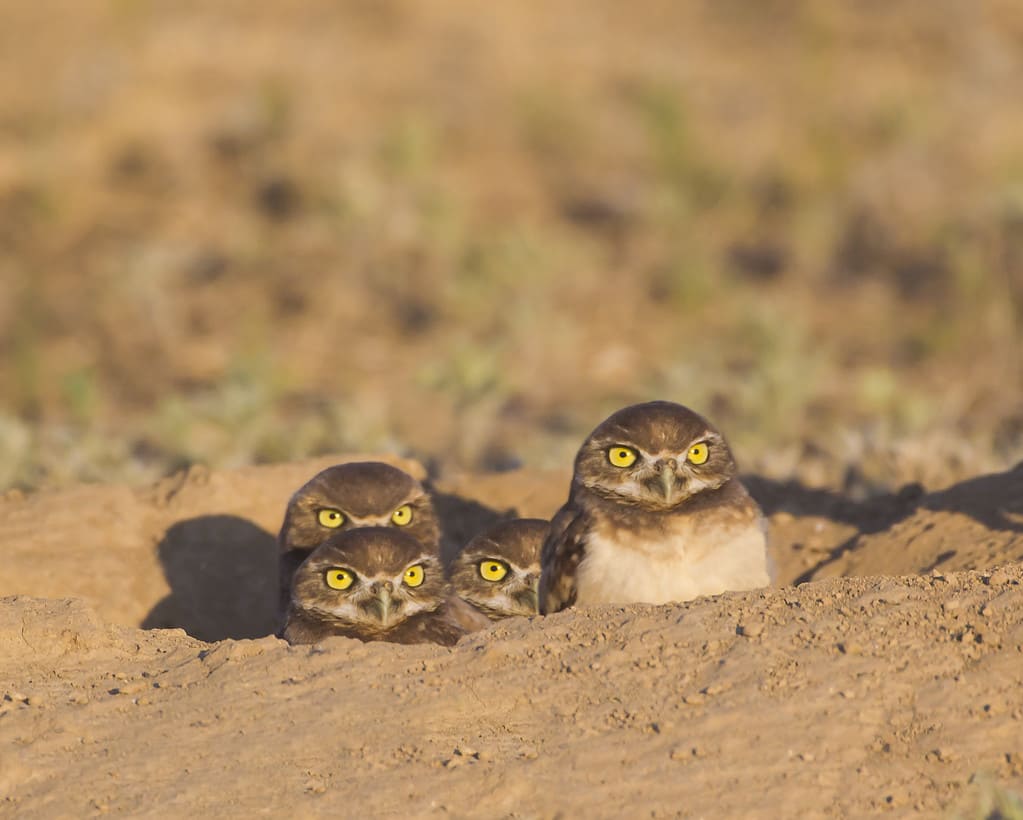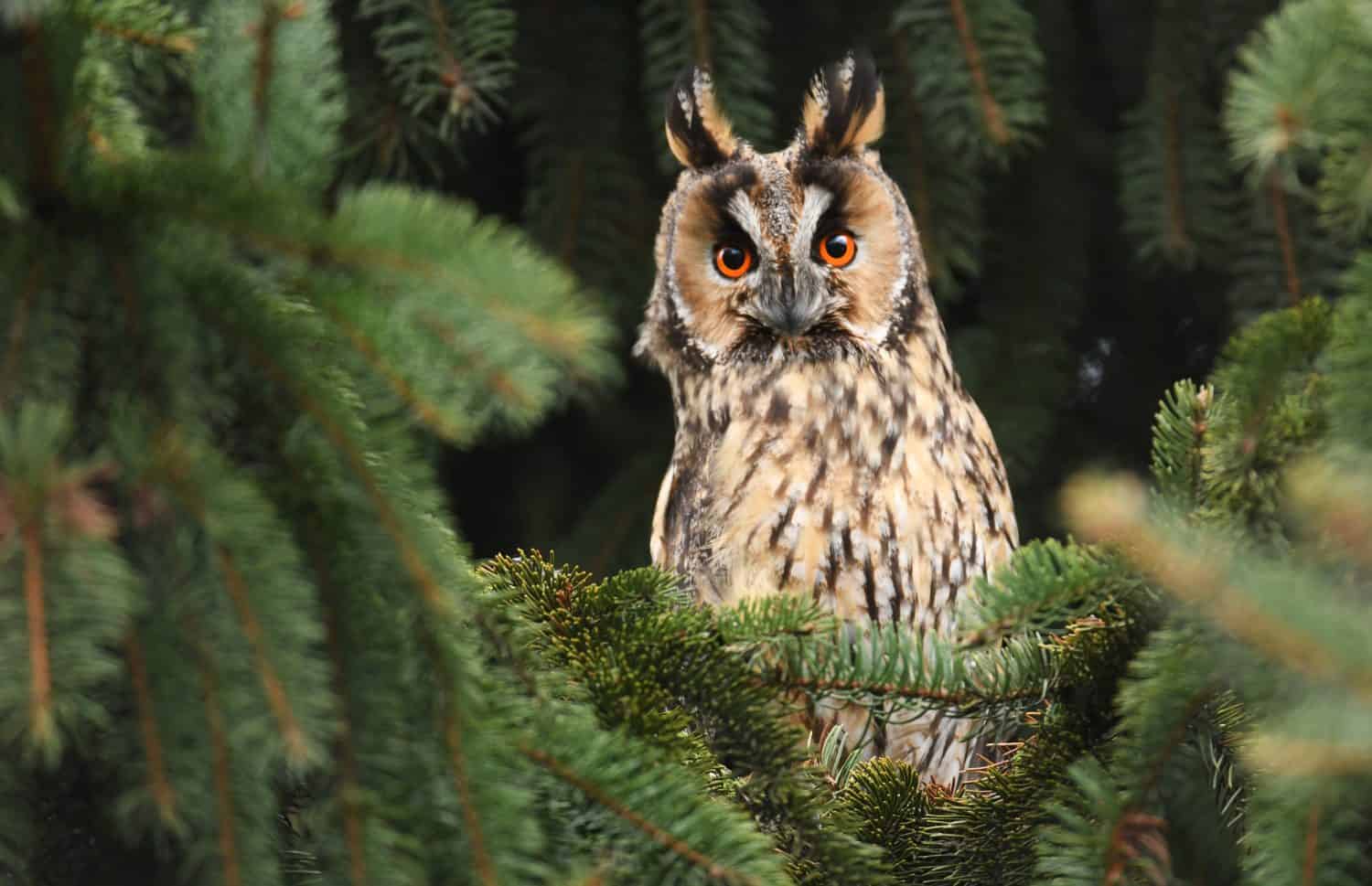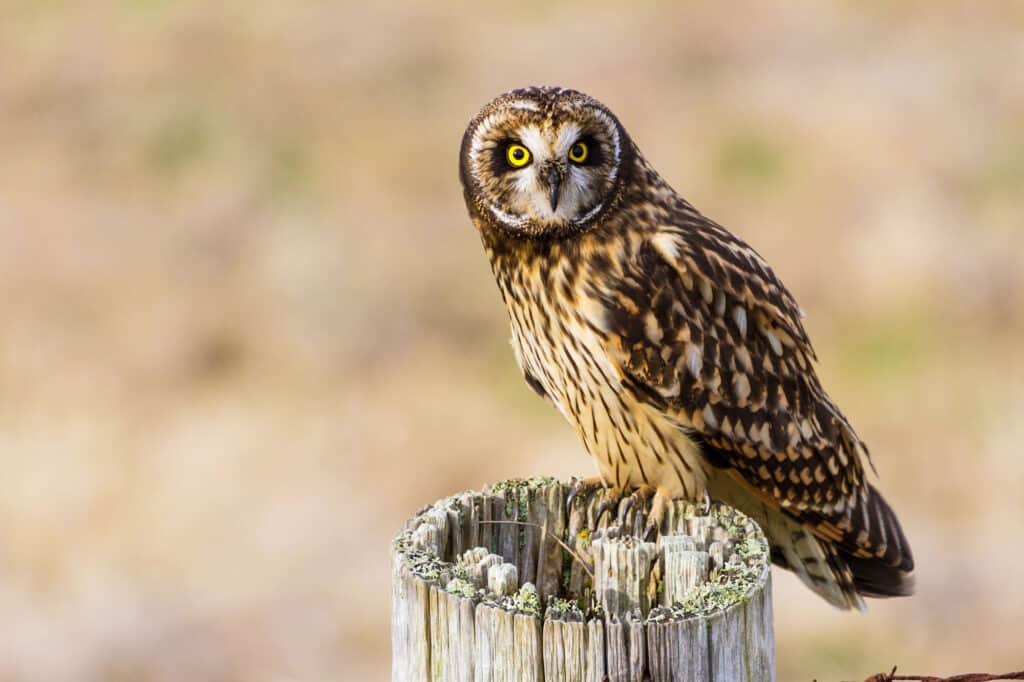The state of California is known for many things: its sprawling wine country, assortment of natural landscapes, and some of the most amazing wildlife in the entire country. In fact, according to the Bureau of Land Management, California has the highest amount of biodiversity in America. Both tourists and nature enthusiasts consider this state a bucket list destination, especially those who enjoy bird watching. If you’re curious about the different types of owls in California, check out these 10 species native to the state.
1. Barn Owl

Barn owls have exceptional vision, which greatly improves their hunting ability.
©Imogen Warren/Shutterstock.com
Even though the barn owl can be found in many places throughout the country, dense populations of these birds live in California. Although barn owls are primarily nocturnal, they become daytime hunters during the winter due to increased food scarcity. This gives people more opportunities to spot them out in the wild!
2. California Great Horned Owl

The diet of great horned owls is varied.
©agustavop/iStock via Getty Images
Great horned owls live in many different places across the state, from deserts to forests. Despite the fact that they may be present in a variety of different environments, their coloration helps them camouflage easily. You’ll have to be patient and creative if you want to catch a glimpse of one of these beauties. Although it might seem obvious, their “horns” aren’t actually horns at all. They’re two large tufts of feathers, which have a horn-like appearance!
3. Burrowing Owl

Burrowing owls often take up residence in burrows built by other animals, such as prairie dogs.
©RichardSeeley/iStock via Getty Images
Equally as quirky as they are cute, the burrowing owl is another common resident of the state of California. Unlike many other owls, burrowing owls are diurnal, meaning that they are active during the daytime. Although these owls have had population declines in recent years, there is a large population of burrowing owls in the Imperial Valley, located in Southern California.
4. Great Gray Owl

In addition to being extremely rare, great gray owls are able to camouflage easily.
©Lynn_Bystrom/iStock via Getty Images
If you want to go great gray owl spotting, California is the place to be, namely Yosemite National Park. According to the National Park Service, “Yosemite, today, is the southernmost range and last sanctuary of almost all of California’s great gray owls, listed as California State Endangered Species. Researchers estimate there are only about 200 to 300 individuals in California, and about 65% of the state’s population resides in Yosemite.”
5. Long-Eared Owl

One of the easiest ways to spot a long-eared owl is to listen for their distinctive call.
©Piotr Krzeslak/Shutterstock.com
Much like the great horned owl, the long-eared owl sports two large feather tufts atop their head. However, seeing one of these owls in real life might prove to be much easier than spotting other entries on this list. Long-eared owls are considered one of the most abundant owl species in the country. They enjoy taking up residence in densely forested areas.
6. Northern Pygmy Owl

Although northern pygmy owls look cute and unassuming, they are adept hunters.
©Jordan Feeg/Shutterstock.com
At only about 17 centimeters tall, the northern pygmy owl is one of the smallest species of owl in California. They are common all throughout the American and Canadian West and can be found as far north as southern Alaska. In addition to their wide distribution, they are also diurnal and most of their peak activity takes place during the daytime hours. This gives bird watchers many opportunities to spot this adorable, tiny owl.
7. Barred Owl

Compared to other owl species, barred owls are easier to spot as they are not strictly nocturnal hunters.
©FotoRequest/Shutterstock.com
The barred owl is abundant throughout the state of California, but this wasn’t always the case. This species originated in the eastern United States and has gradually spread westward. Since their arrival, experts believe that barred owls may be adversely impacting other Californian owl species. The smaller and less aggressive spotted owls that share territory with barred owls have experienced a decline in their populations in recent years. The California Department of Fish and Wildlife recognizes this and has taken action to prevent further damage caused by barred owls.
8. California Spotted Owl

Unlike other owl species, spotted owls have dark eyes.
©C.M.Corcoran/Shutterstock.com
As mentioned above, California spotted owls have been growing more and more scarce in the last few decades, and sightings are far and few between. In addition to the barred owl’s interference with this species, their natural habitat has been destroyed, disease has become more widespread, and climate change has affected them. Despite this, conservation efforts are high, and professionals remain hopeful that their numbers will recover in the future.
9. Western Screech Owl

Male western screech owls are more likely to use their calls than females.
©Steve Bruckmann/Shutterstock.com
Western screech owls might be tiny, but their personality is mighty! This species is known to attack animals that are bigger than they are. Despite their small stature, they often end up successful in these ventures due to their confidence and aggressive behavior. In addition, western screech owls are masters of disguise. In order to evade predators, they contort their bodies in order to blend in with tree trunks or branches. Because of this camouflage ability, seeing one may be difficult, even for the most experienced birders.
10. Short-Eared Owl

Short-eared owls do not enjoy living in forested areas.
©iStock.com/Devonyu
The short-eared owl is another species that is present around the globe. Unlike other owls, the short-eared owl is not fond of taking up residence in forested areas. Instead, this owl can be found in grasslands, marshes, bogs, and farmland. Although they are called “short-eared,” these owls almost seem to be lacking ears entirely, as they are difficult to spot. In fact, spotting a short-eared owl at all might be a challenge. They may be easier to spot than some other California owls, but their small size and elusive nature make encountering one a rare experience!
| Owl | Difficulty of Spotting |
|---|---|
| Barn owl, long-eared owl, northern pygmy owl | Relatively easy |
| California great horned owl, burrowing owl, barred owl, short-eared owl | Moderately easy |
| Great gray owl, California spotted owl, western screech owl | Somewhat challenging |
The photo featured at the top of this post is © MZPHOTO.CZ/Shutterstock.com
Thank you for reading! Have some feedback for us? Contact the AZ Animals editorial team.







